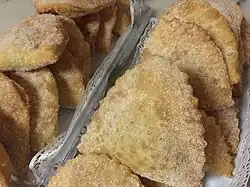 Azevias | |
| Alternative names | Farto |
|---|---|
| Type | Pastel Conventual sweet |
| Course | Dessert |
| Place of origin | Portugal |
| Region or state | Évora, Alentejo |
| Main ingredients | Pastry (flour, eggs, lard, olive oil, water, salt), sugar |
| Ingredients generally used | Cinnamon, orange juice, almonds |
| Variations | Grão (chickpea) Batata doce (sweet potato) Gila (chilacayote) Feijão (navy bean) |
Azevias (singular: azevia) are traditional Portuguese fried pastries, turnovers filled with a sweet filling.[1]
Because of their thin profile compared to similar fried turnovers, they were named after a type of sole, a flatfish found in Portuguese waters. Recipes for azevias were first recorded in the refectory notebooks and cookbooks of the Poor Clare nuns of the Convent of Santa Clara in Évora.[2][3]
The dough is similar to a hot water crust, containing lard and warm water.[4] Orange juice is sometimes added or used in place of water. The most common filling flavors are made with chickpeas, sweet potatoes, chilacayote jam, or navy beans.[5] It is often mixed with egg yolks and ground almonds, typical ingredients characteristic of many Portuguese desserts, especially conventual sweets. After frying, they are coated with sugar and cinnamon.[3]
Although azevias are made throughout the year, they are particularly popular during the Christmas season and on Carnaval.[6] During Carnaval, cotton is sometimes used as a filling as a prank.[7]
See also
- Pastel
- Pasteles
- Pastel (Brazilian)
- Pastel (Portuguese)
- Portuguese Cuisine
References
- ↑ The Big Book of Christmas Recipes. Dyfed Lloyd Evans. Retrieved 23 October 2023.
- ↑ Rodrigues, Domingos (1836). Arte de Cozinha dividida em tres partes, ... e nesta ultima impressão accrescentada offerecida ao Sr. A. Monteiro de Campos. Edited by J. Gomes Malicia (in Brazilian Portuguese). Retrieved 23 October 2023.
- 1 2 Fernandes, Daniel. "Azevias". Produtos Tradicionais Portugueses. Direção-Geral de Agricultura e Desenvolvimento Rural. Retrieved 23 October 2023.
- ↑ Martins, Ana Carolina Faria (23 October 2021). "Development of innovative vegetable preparations for the pastry industry" (PDF) (in Portuguese). Library of the University of Minho: 19. Retrieved 23 October 2023.
{{cite journal}}: Cite journal requires|journal=(help) - ↑ Dieta Mediterranica (in European Portuguese). Teleculinária. ISBN 978-989-99843-4-9. Retrieved 23 October 2023.
- ↑ "Fritos de Natal: descubra as diferenças". Pingo Doce (in Portuguese). 4 December 2016. Retrieved 23 October 2023.
- ↑ Pereira, Berenice (28 January 2012). "Azevias de Grão (Évora)". Cozinha Tradicional (in Brazilian Portuguese). Retrieved 23 October 2023.